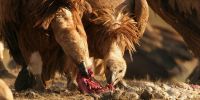Vulture Conservation
Current and Future Conservation research aspects with vulture conservation in Rajasthan, India
India has nine species of vultures in the wild. These are the Oriental White-backed Vulture (Gyps bengalensis), Slender billed Vulture (Gyps tenuirostris), Long billed Vulture (Gyps indicus), Egyptian Vulture (Neophron percnopterus), Red Headed Vulture (Sarcogyps calvus), Indian Griffon Vulture (Gyps fulvus), Himalayan Griffon (Gyps himalayensis), Cinereous Vulture (Aegypius monachus) and Bearded Vulture or Lammergeier (Gypaetus barbatus). The population of three species i.e. White-backed Vulture, Slender billed Vulture and Long billed Vulture in the wild has declined drastically over the past decade. The decline of Gyps genus in India has been put at 97% by 2005.
Because of the evidence of widespread and rapid population decline, all three vulture species were listed by IUCN, the World Conservation Union, in 2000 as ‘Critically Endangered’, which is the highest category of endangerment. This assessment indicated a high risk of global extinction in the wild in the near future.
India also moved a IUCN motion in 2004 for vulture conservation, which was accepted in the form of the IUCN resolution which “called upon Gyps vulture Range countries to begin action to prevent all uses of diclofenac in veterinary applications that allow diclofenac to be present in carcasses of domestic livestock available as food for vultures; establishment of IUCN South Asian Task Force under the auspices of the IUCN; Range countries to develop and implement national vulture recovery plans, including conservation breeding and release.”
Legal Issues in Phasing Out of Diclofenac:
Do sufficient legal powers exist with the Government to terminate use of Diclofenac? The Drugs & Cosmetics Act 1940 was amended in 1982 to empower the Central Govt. to prohibit manufacture and import of drugs under Sec. 26-A and 10A respectively of the Drugs and Cosmetics Act. Sections 10A (Power of Central Govt to prohibit import of drugs and cosmetics in public interest) and 26A of the Act (Power of Central Govt to prohibit manufacture of drugs and cosmetics in public interest) state.
Drugs, for which harmful effects are reported, or if therapeutic justification is considered inadequate in the light of current medical evidence, are examined by the Expert Committee under the Drugs Technical Advisory Board (DTAB), which is a statutory Board under the Drugs and Cosmetics Act. Similarly, drugs for animal use are examined by the Directorate General of Health Services, Ministry of Health, in consultation with the Ministry of Agriculture. However such alternative drugs should be identified that are not only safe and effective in livestock, but also safe for vultures and other scavenging birds and animals. As per procedure, once a suitable drug for replacing Diclofenac for veterinary use is identified and concurrence received from the Ministry of Agriculture, manufacture, import, sale, and distribution of Diclofenac for veterinary use may be prohibited under Sections 10A and 26A of the Drugs and Cosmetics Act, 1940 through notification in official Gazette.
Conservation progress
View Vultures Galleries
Population Estimations
Wildlife population estimations for key engendered species

